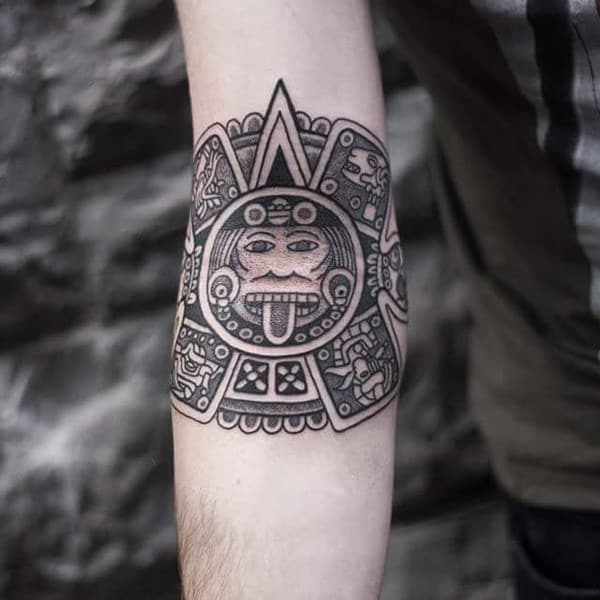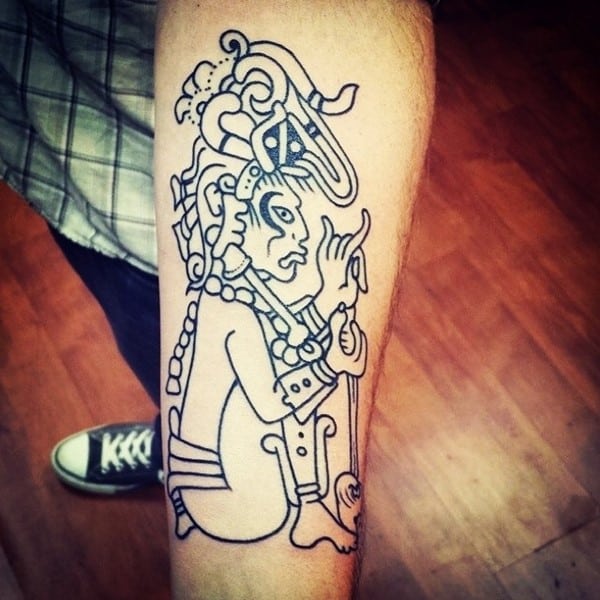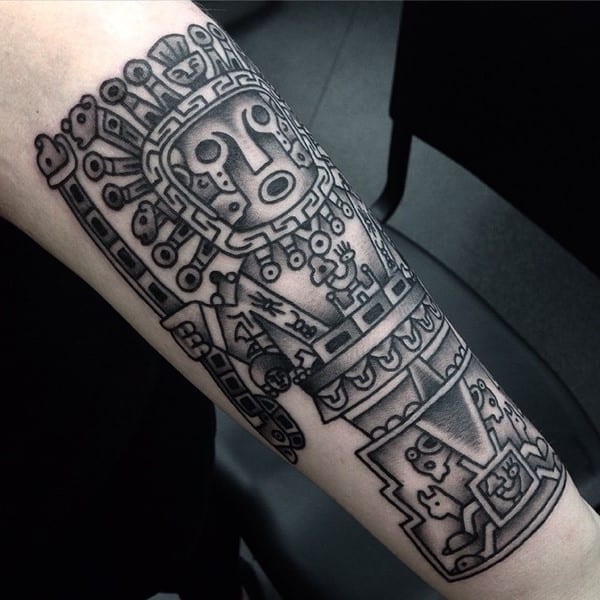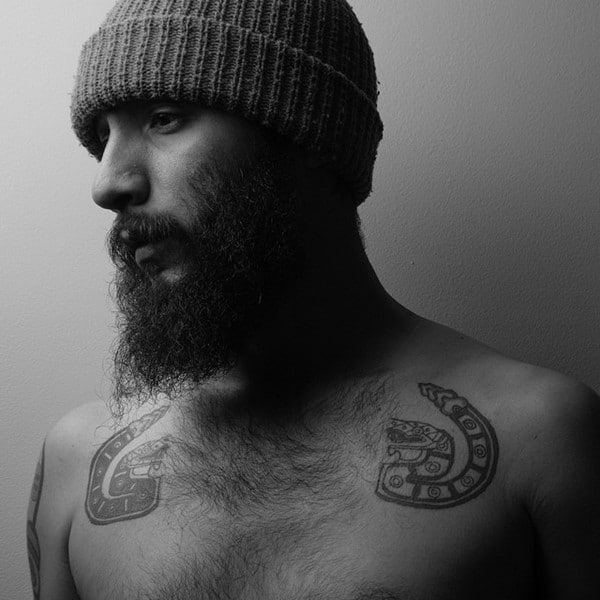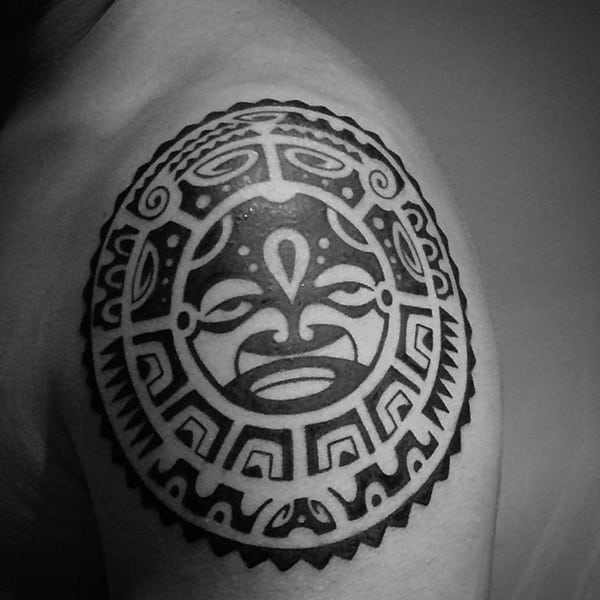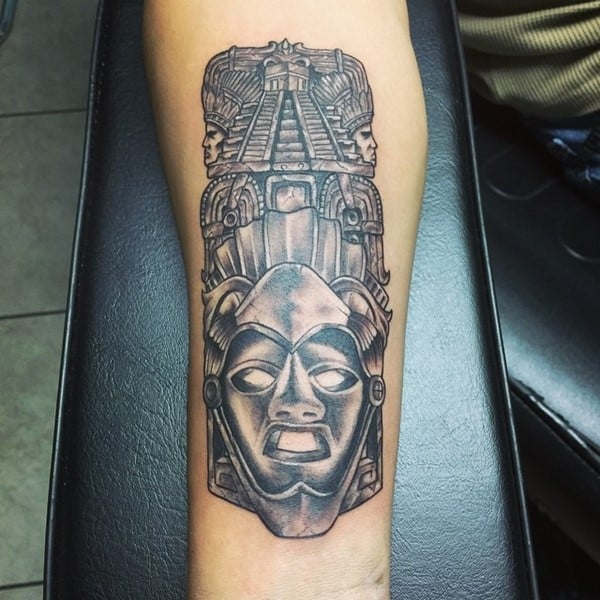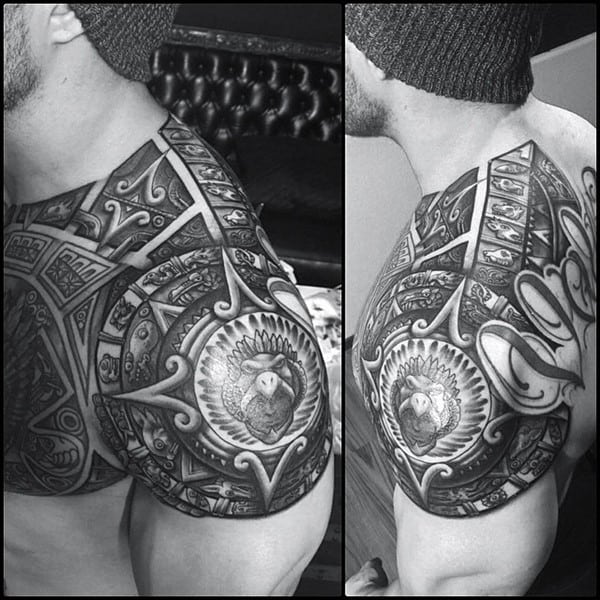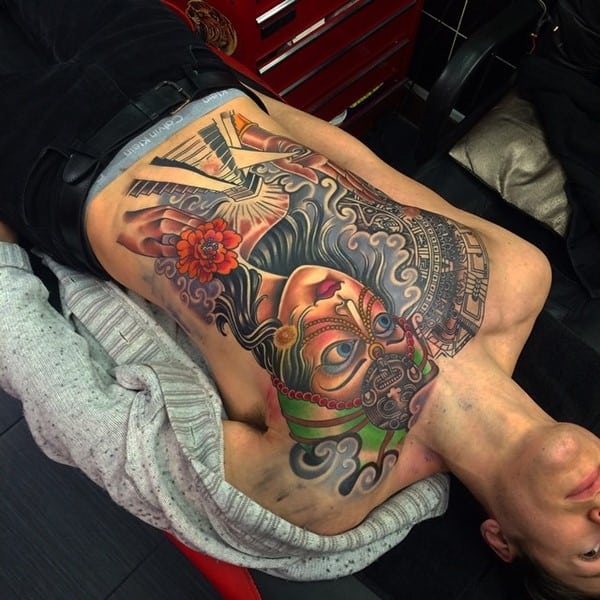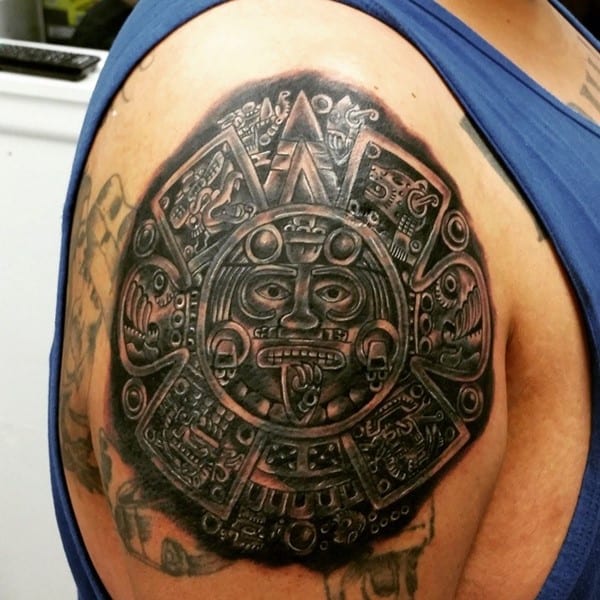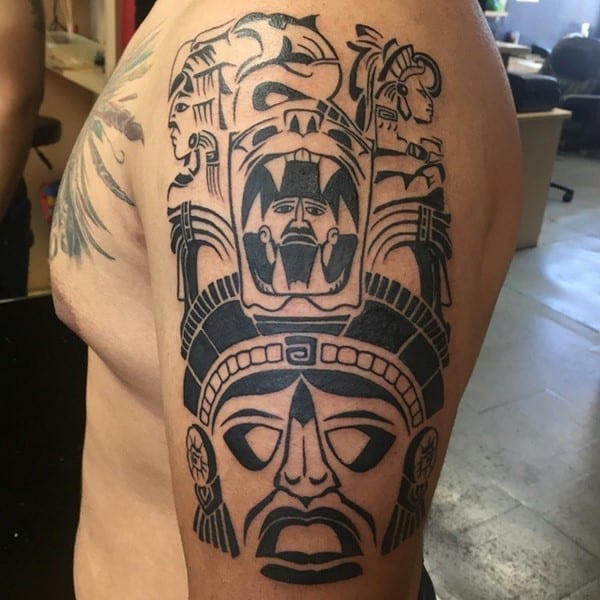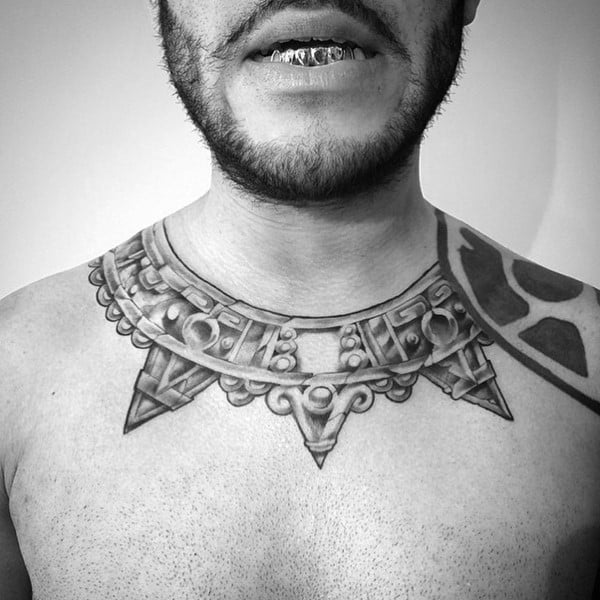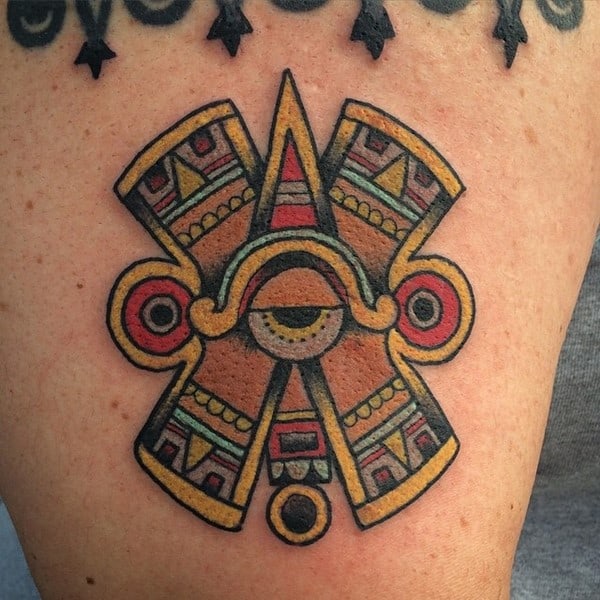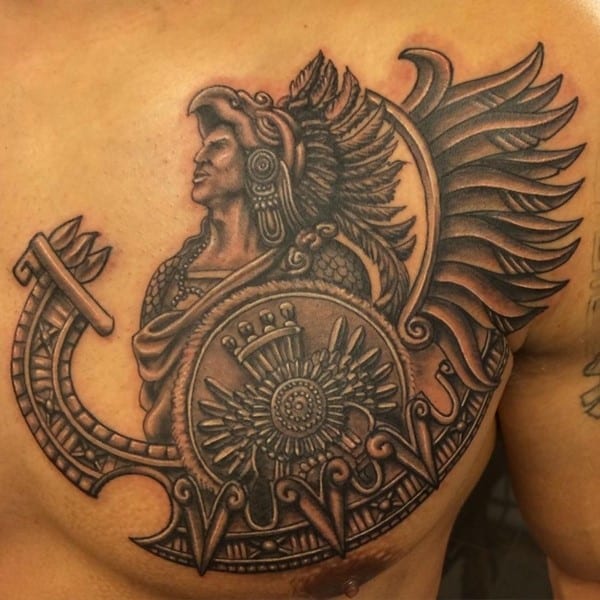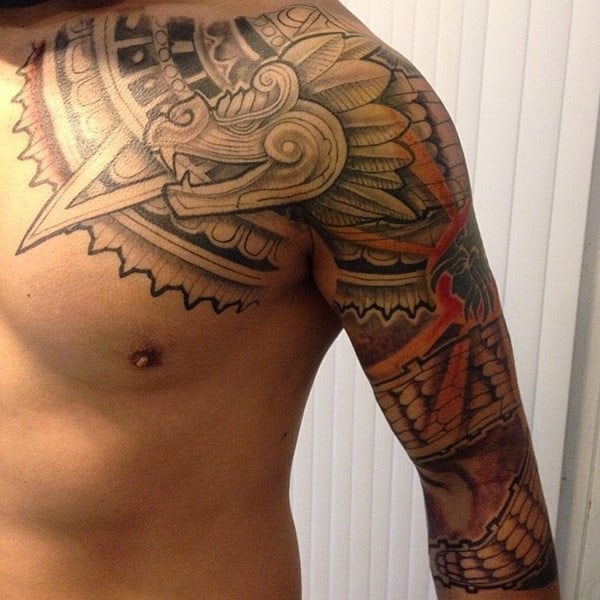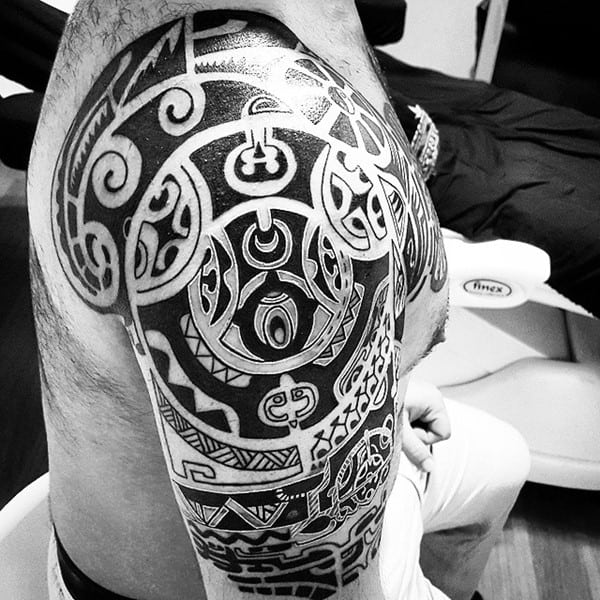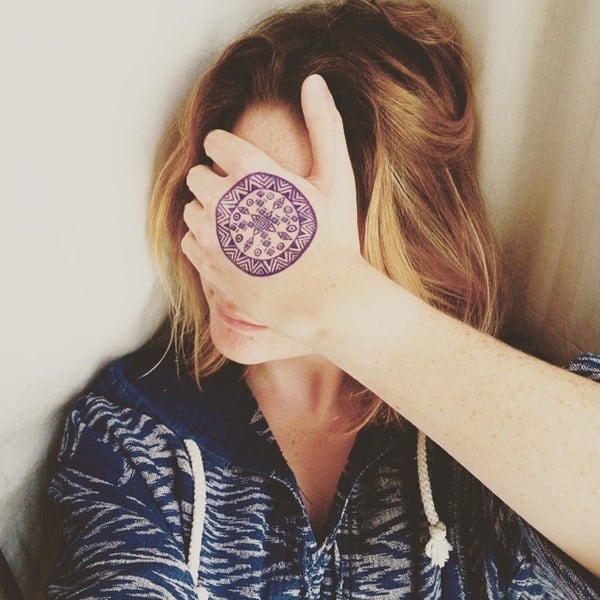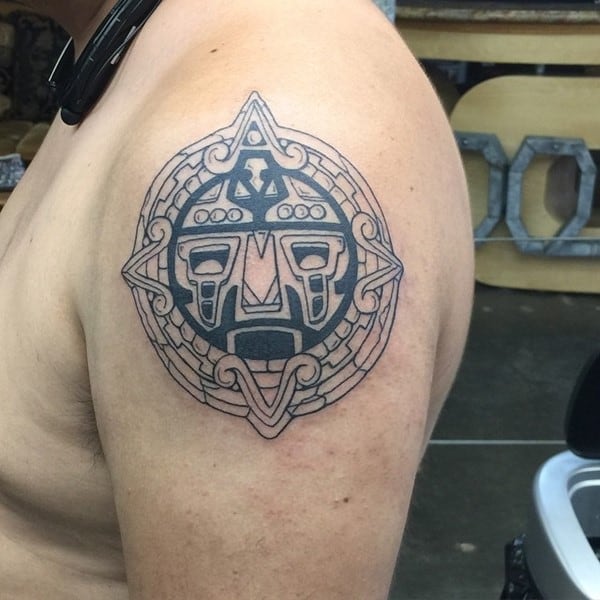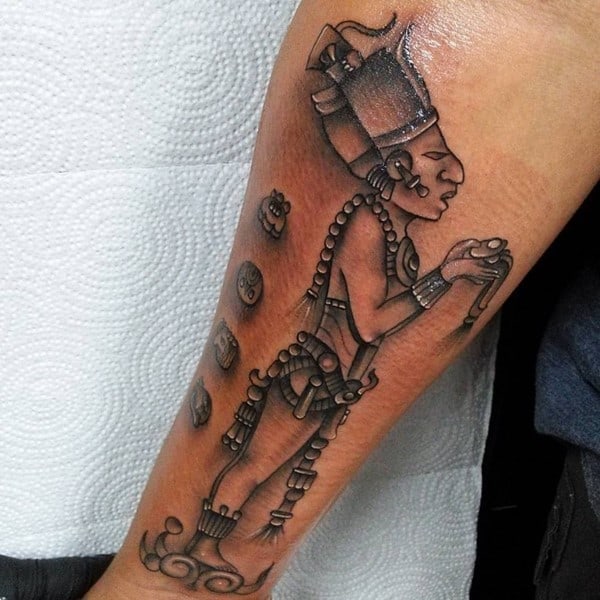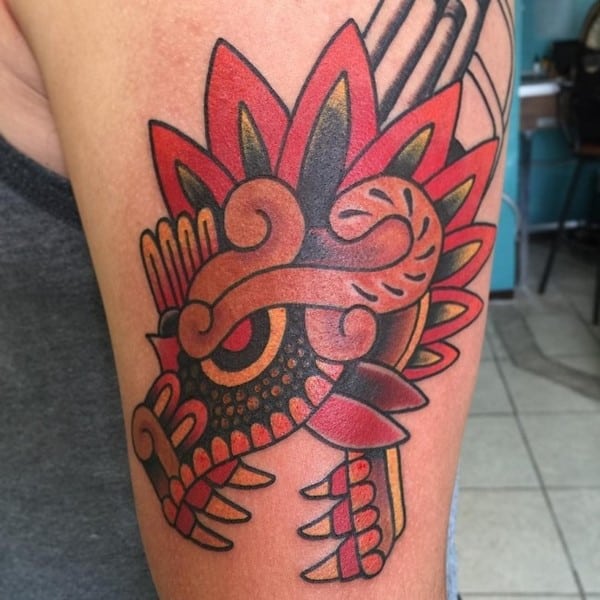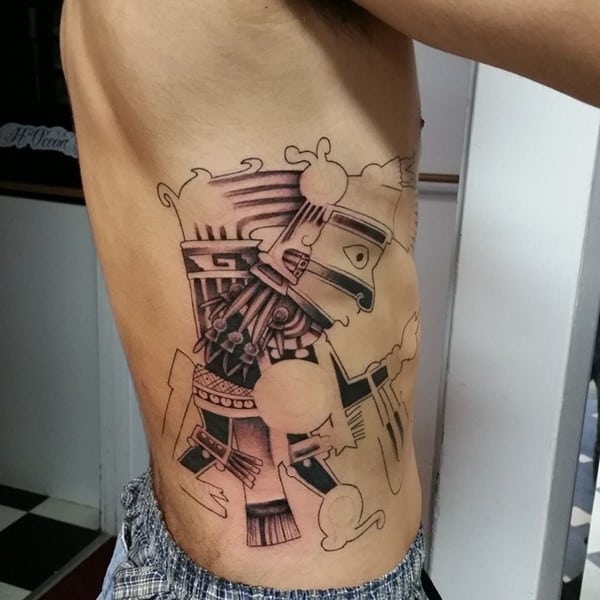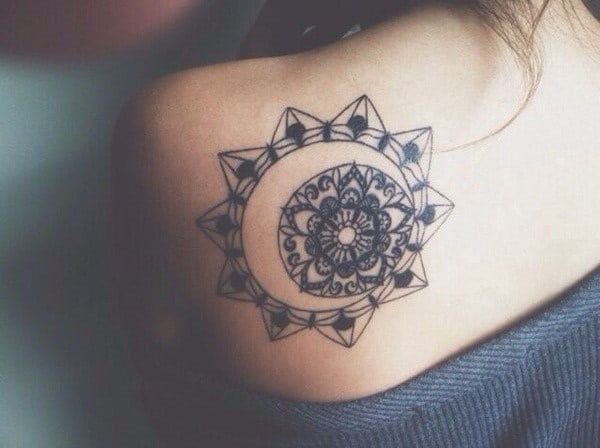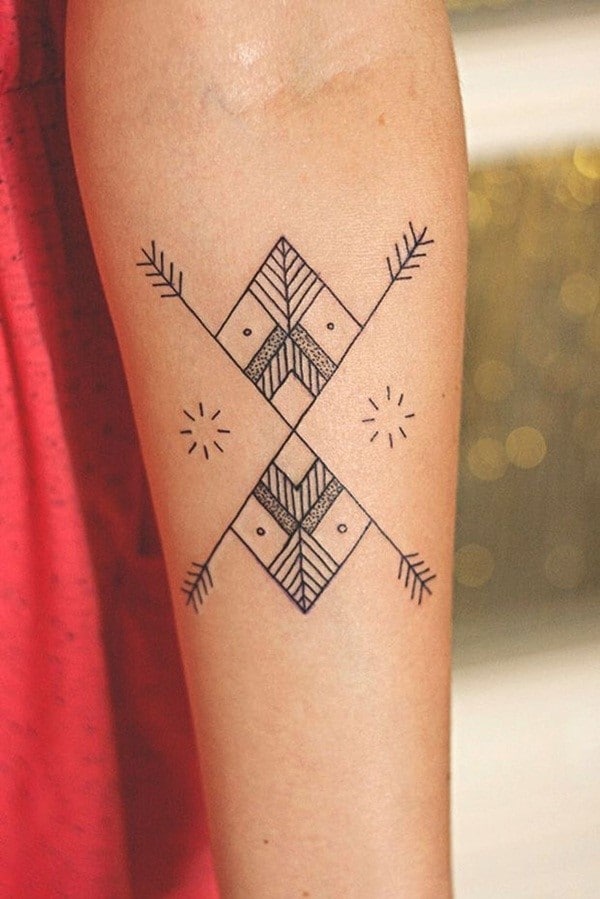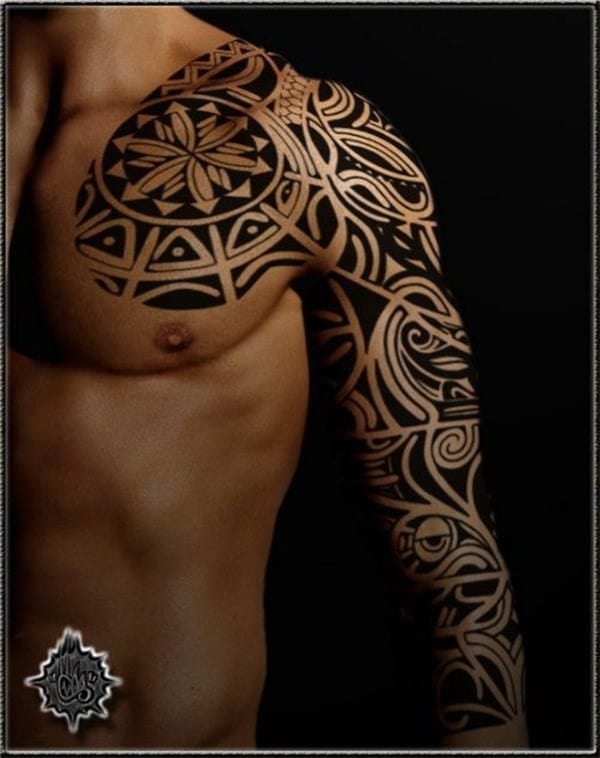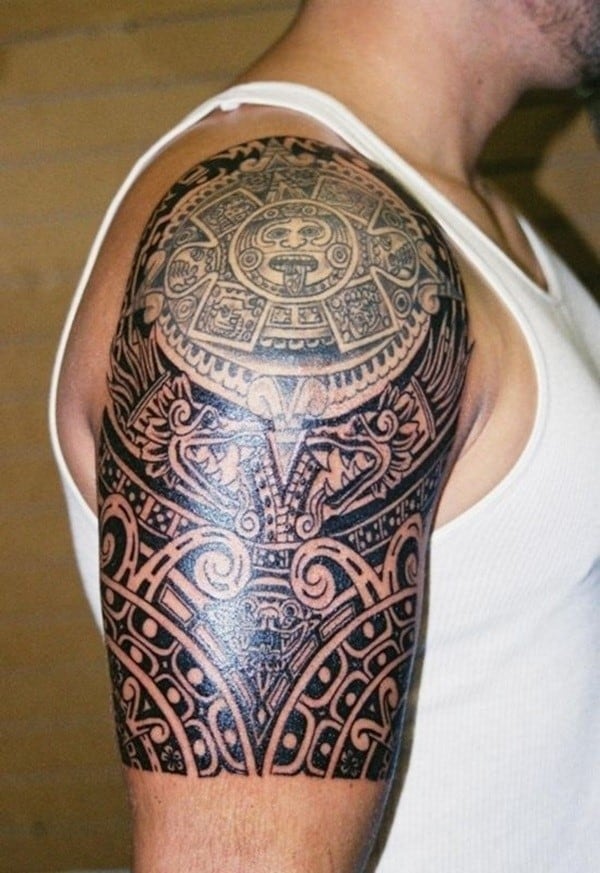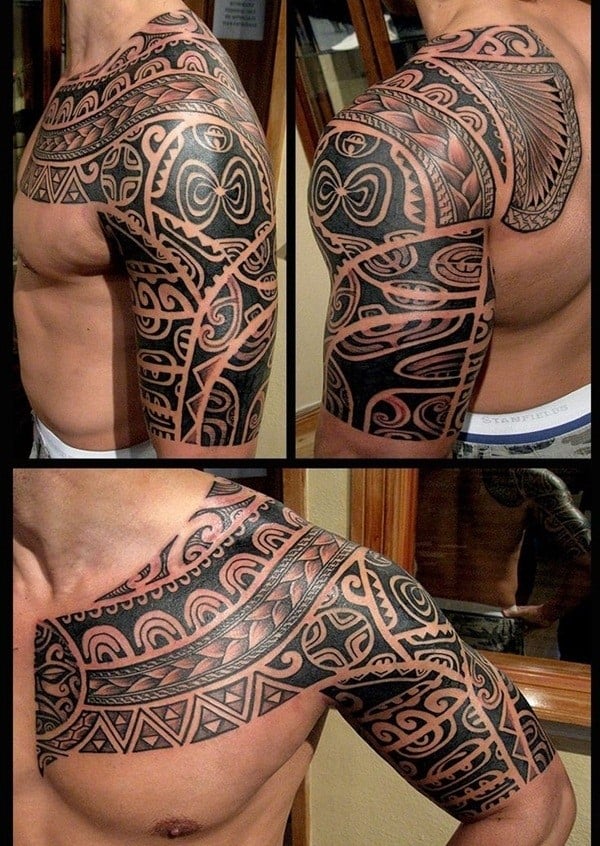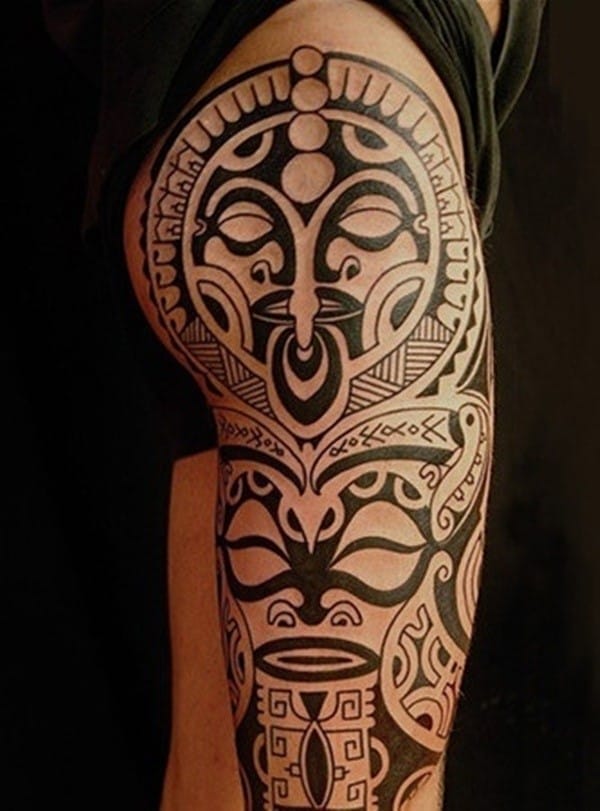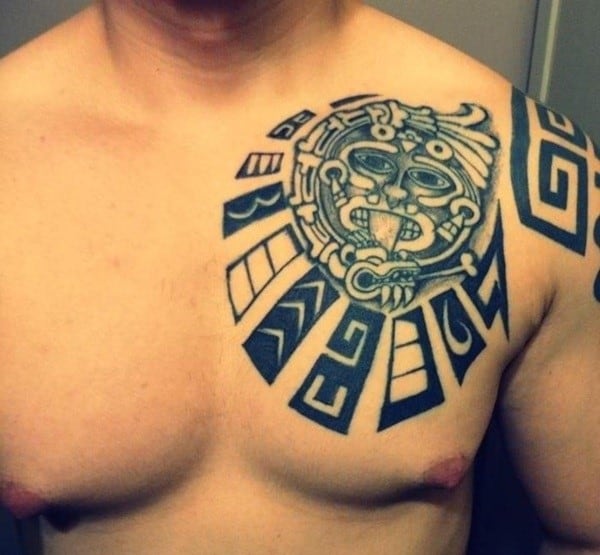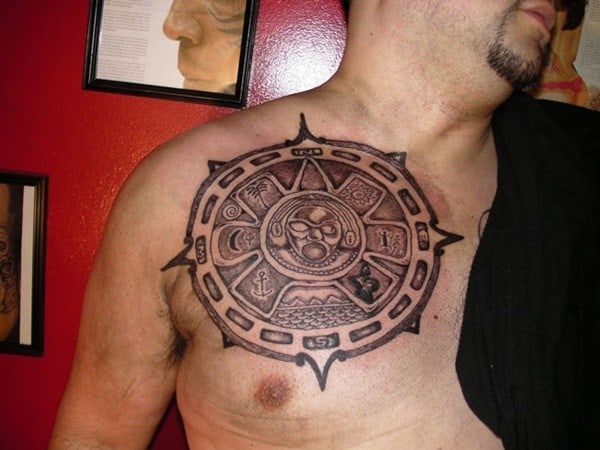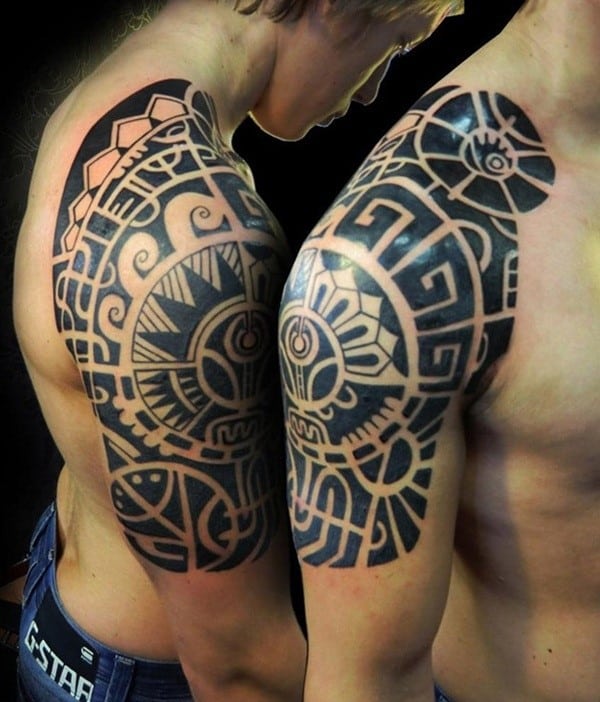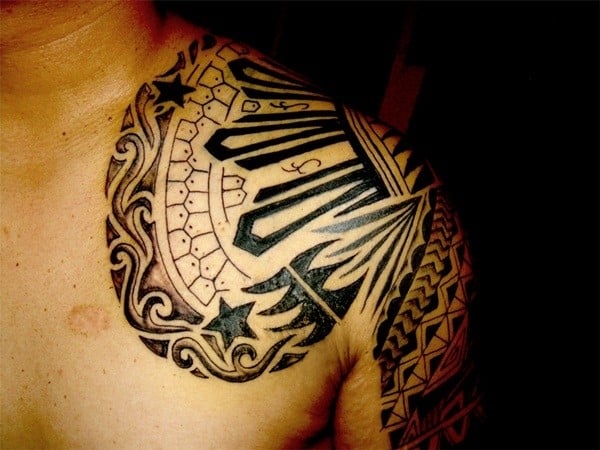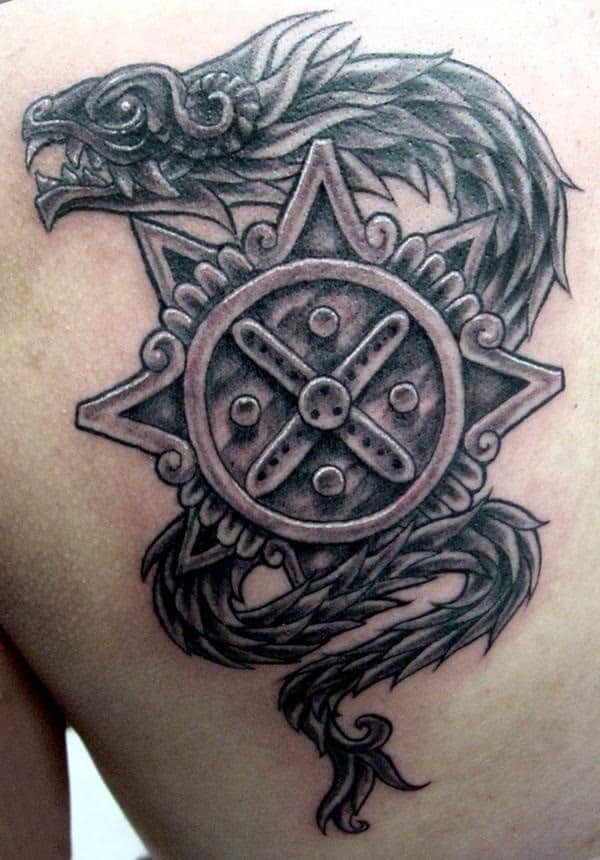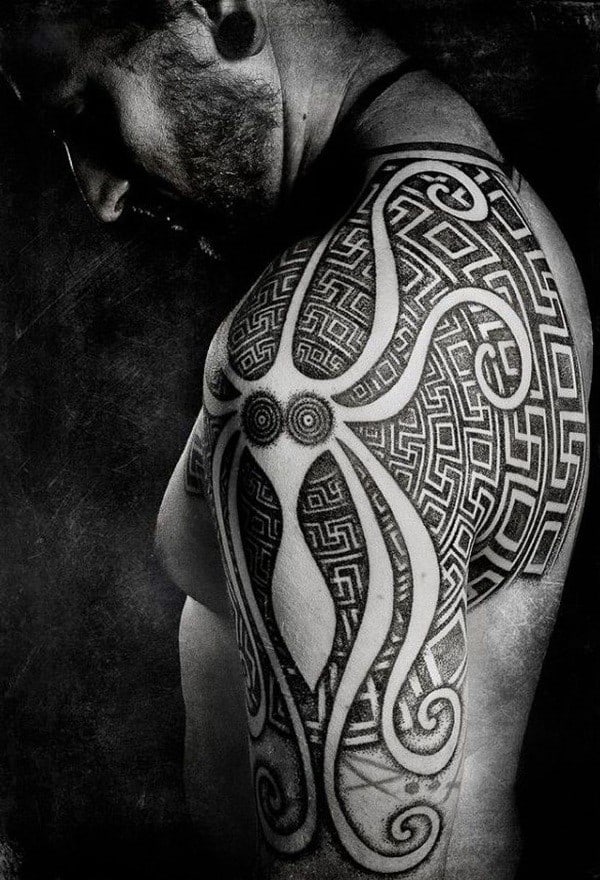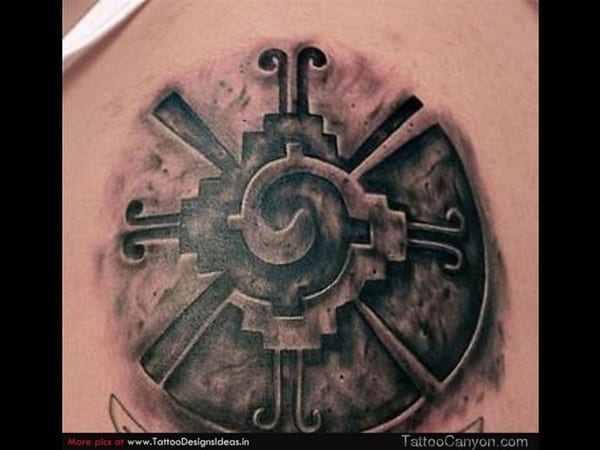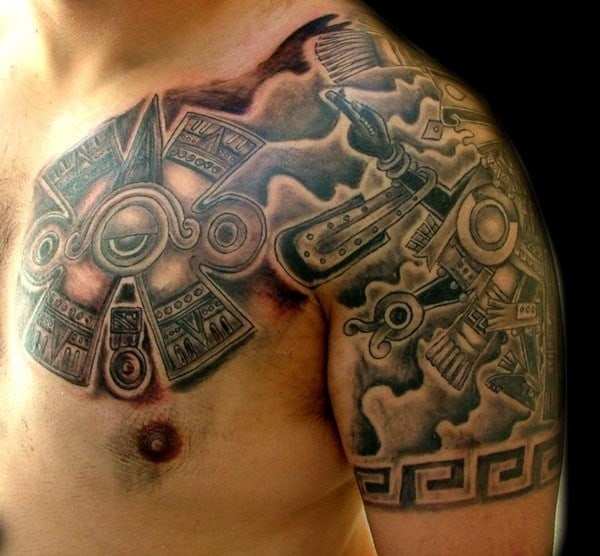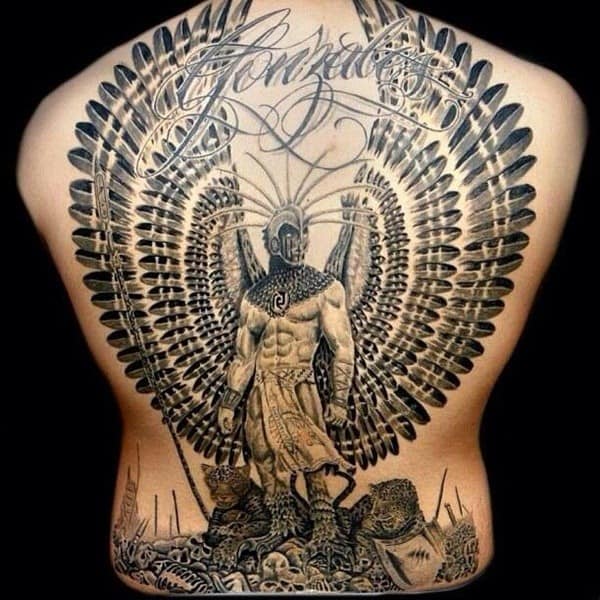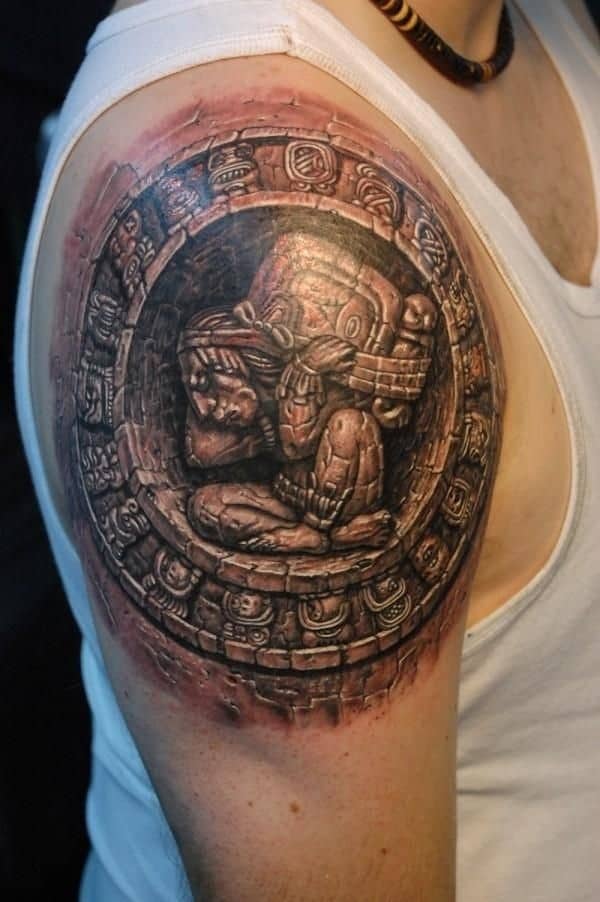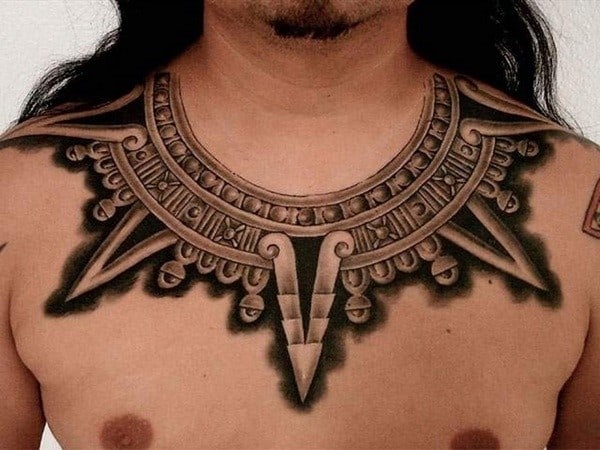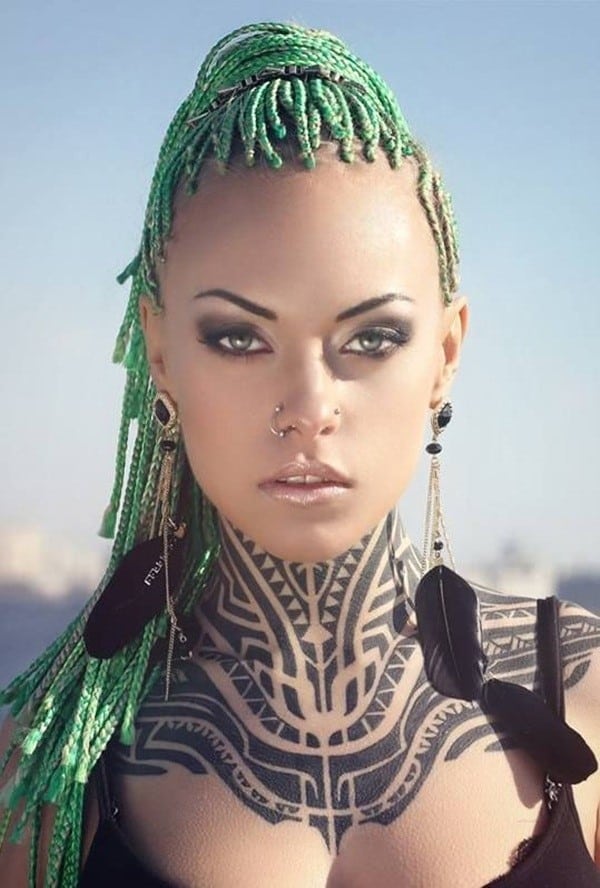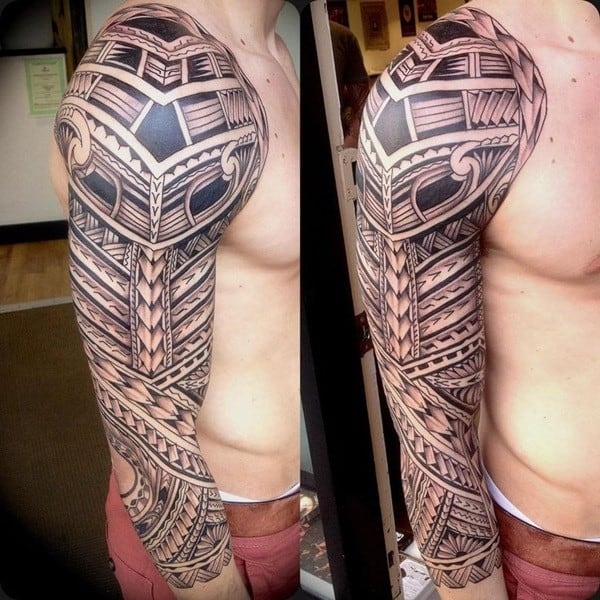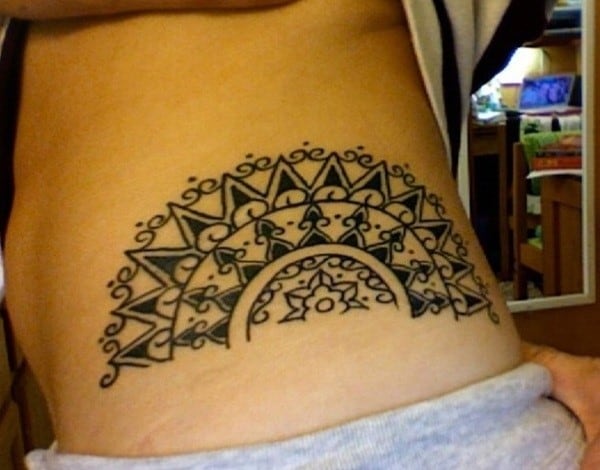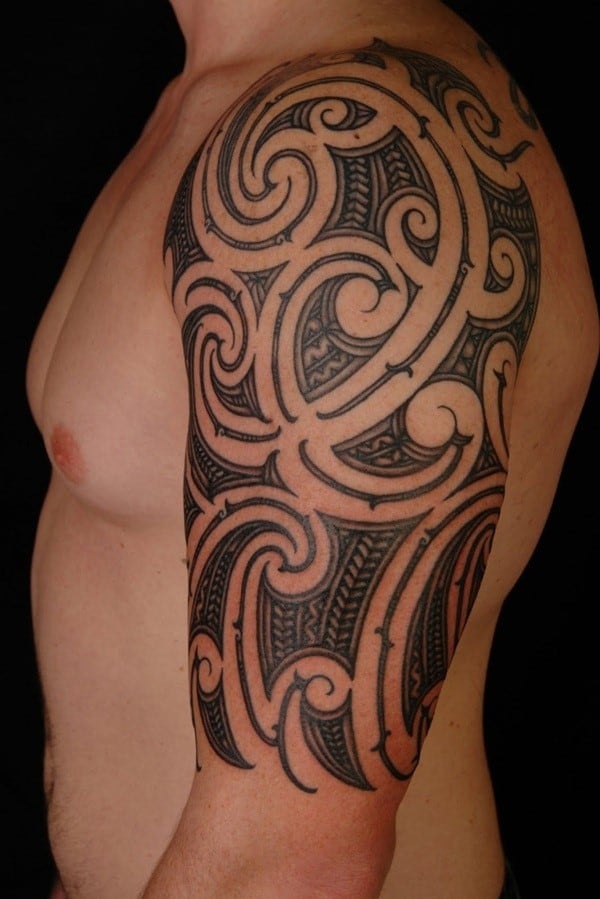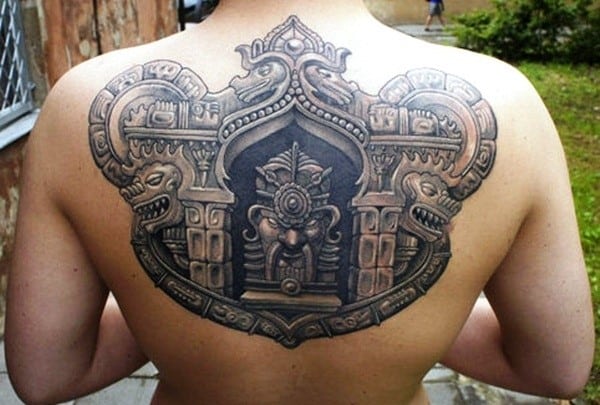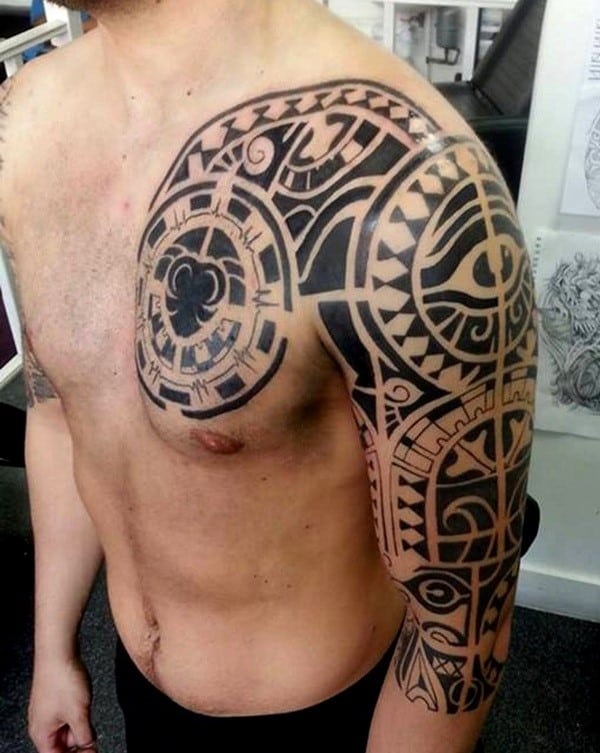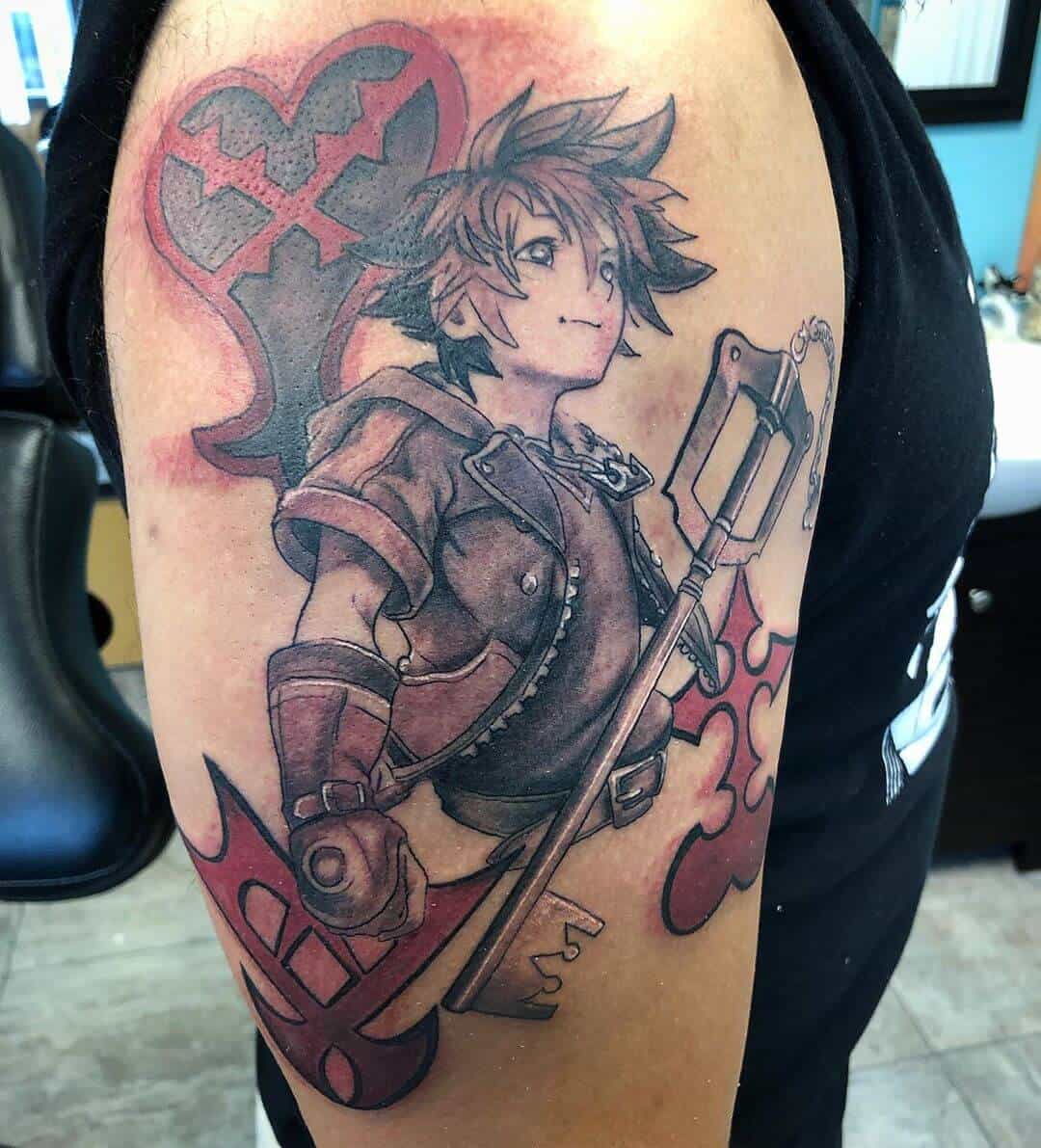Looking for some Aztec tattoo inspiration? Don’t miss these stunning design ideas!
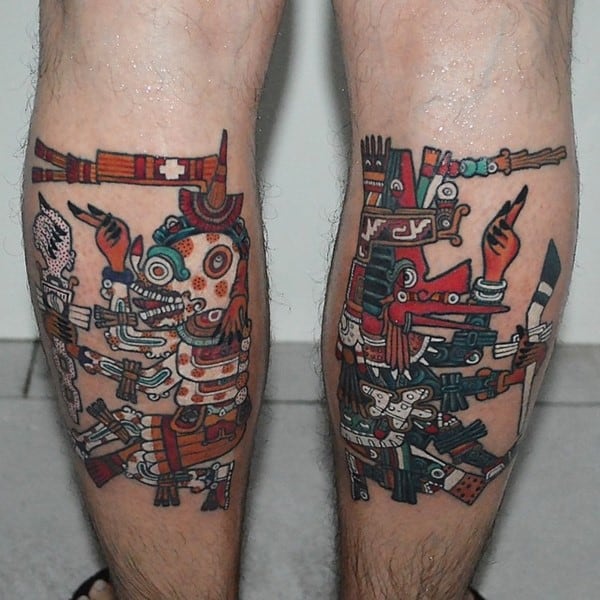
Until relatively recently, tribal tattoos were seen in modern cultures as mostly generic – abstract patterns of spiky lines.
Nowadays, however, designs inspired by specific tribes are gaining in popularity. This is why in this article, we’re going to focus on tribal tattoos of the Aztec civilization.
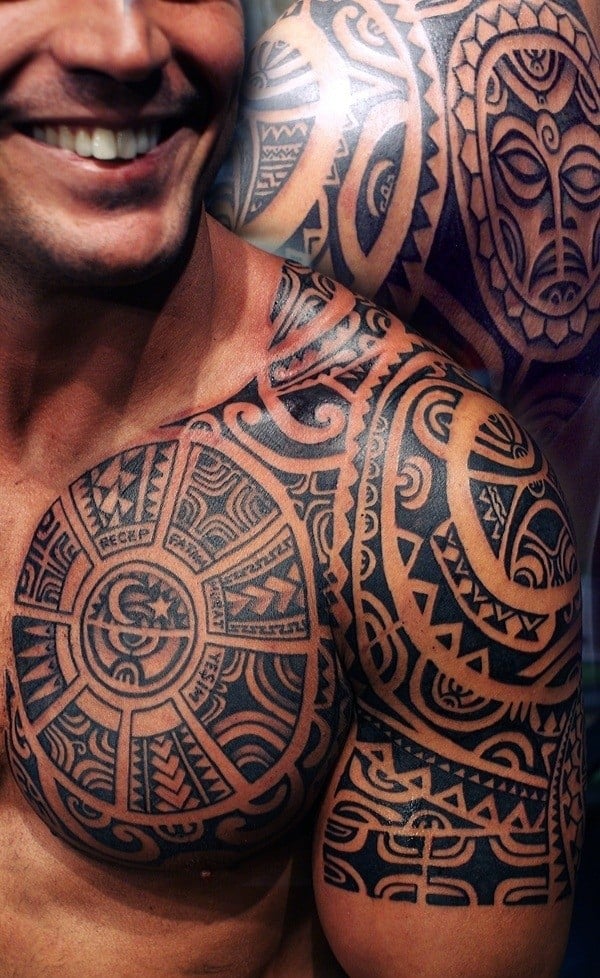
The Aztecs
Not much is known about this ancient civilization. Most sources agree that the Aztecs were originally a nomadic tribe from northern Mexico, who arrived to settle in Mesoamerica at the beginning of the 13th century. They were also known as the Tenochca or the Mexica.
The Aztecs rapidly expanded their territory and influence – their language, Nahutal, became the common language in central Mexico by as early as the mid-1350s. By the 15th century, the Aztec Empire was the dominant force in the area.
The end of the Empire’s reign came in 1521 in the form of Spanish conquistadors, who captured Tenochtitlan, the Aztec capital, overthrowing the Aztec Empire once and for all.
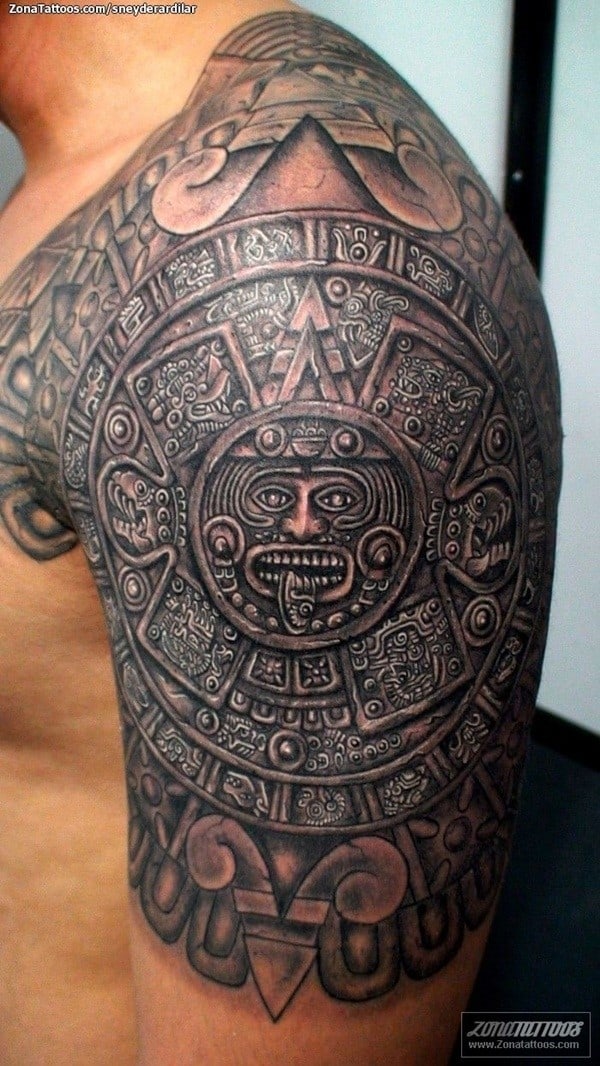
The Aztec culture
The Aztecs are widely known for their ruthless, brutal ritual sacrifices. To be fair, this view is not without merit – literally hundreds of thousands of human skulls, believed to come from victims of human sacrifice, have been discovered at Aztec religious sites. (Warning – pretty gruesome reading)
The sacrifices, involving animals and humans – usually war prisoners, taken from the losing sides of battles – were aimed at appeasing the gods, ‘feeding’ the deities to ensure prosperity and ward off danger.
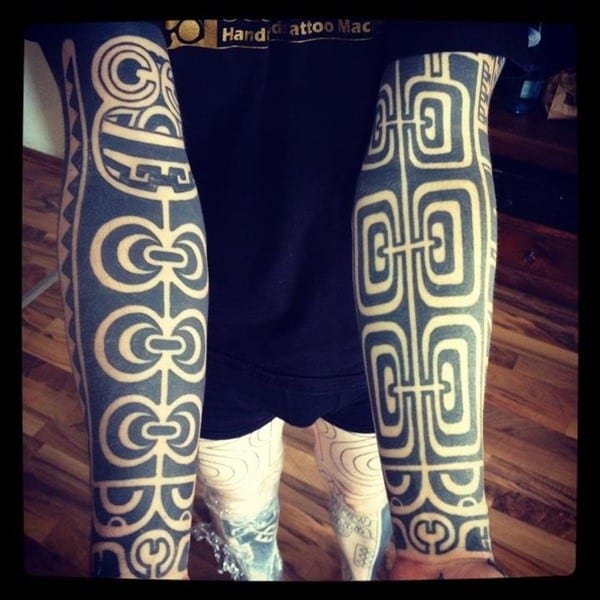
That being said, the Aztec civilization would never have flourished in the way it had without well-developed cultural, political, spiritual, and economic aspects.
The Aztecs were particularly fond of art and architecture, with well-organized guilds of artisans who specialized in metalwork, wood carvings, and stone sculpture.
Recommended Next: Don’t miss our guide to Samurai tattoos next!
Modern-day Aztec body art draws heavily on the remnants of this art. Aztec sculptures and decorations, particularly the ornamental patterns on Aztec pottery, are the main inspiration behind Aztec tattoo designs.
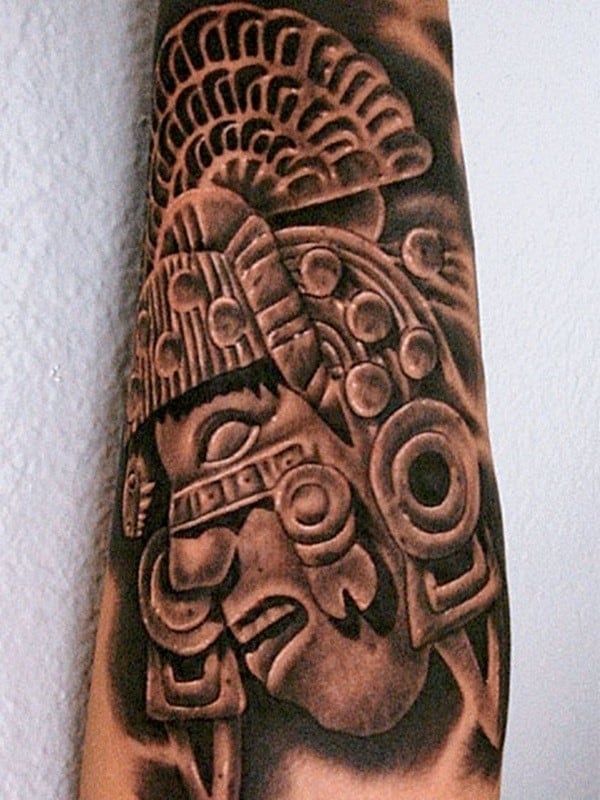
Tattoos in the Aztec Empire
There is little reliable information available about the extent of tattooing among Aztecs. What we do know for sure is that they used body painting – war paint for warriors before battle and ritual painting for priests before ceremonies.
Though hard evidence for Aztec tattooing is missing, scholars note that all cultures around the Aztecs engaged in permanent body art – the Mayans, Huaxtec, and Otomi people certainly did. This leads most researchers to believe that the Aztecs would likely have tattoos as well.
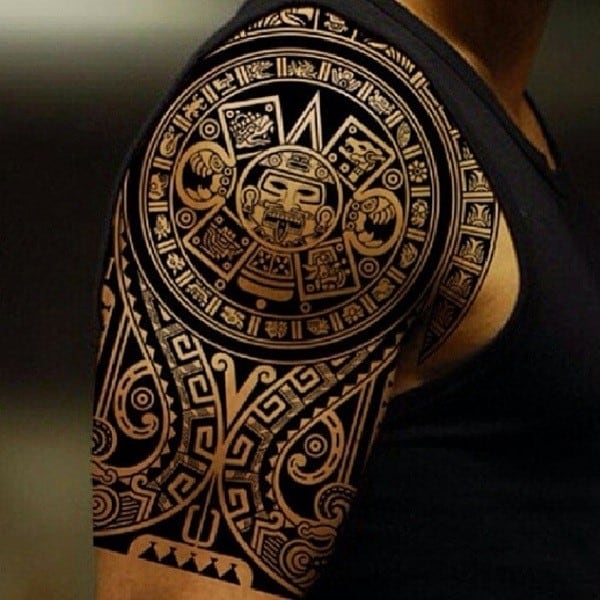
Aztec religion and spirituality
Most of the Aztec art which inspires Aztec tribal tattoos today revolves around religious and spiritual themes, so it’s worth taking a closer look at the Aztec religion to better understand the symbols and creatures we see in tattoo designs.
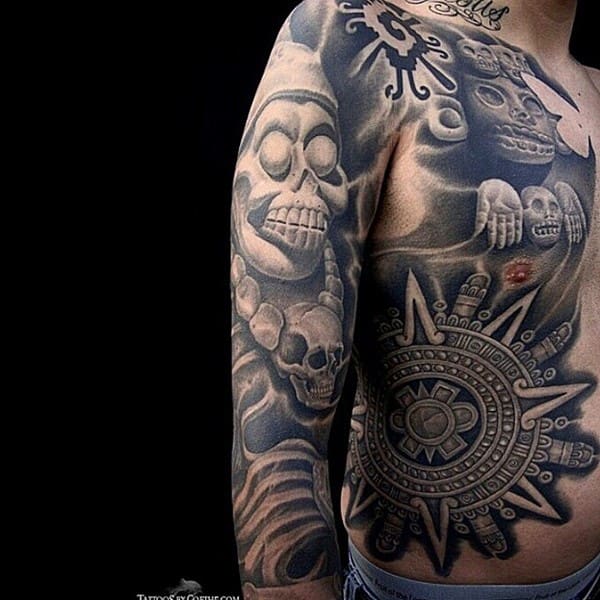
The Aztec religion was polytheistic – meaning there were many gods in the Aztec pantheon, each with different characteristics and attributes.
Recommended Reading: Our guide to gang tattoos is worth checking out!
Huitzilopochtli
Huitzilopochtli was the god of war and the sun, and one of the most important deities. He was believed to have sent an eagle to guide the first Aztecs to settle in the land that became their empire.
He was often depicted as having blue arms and legs and carrying a snake-shaped spear-thrower, a shield, or feathered arrows.
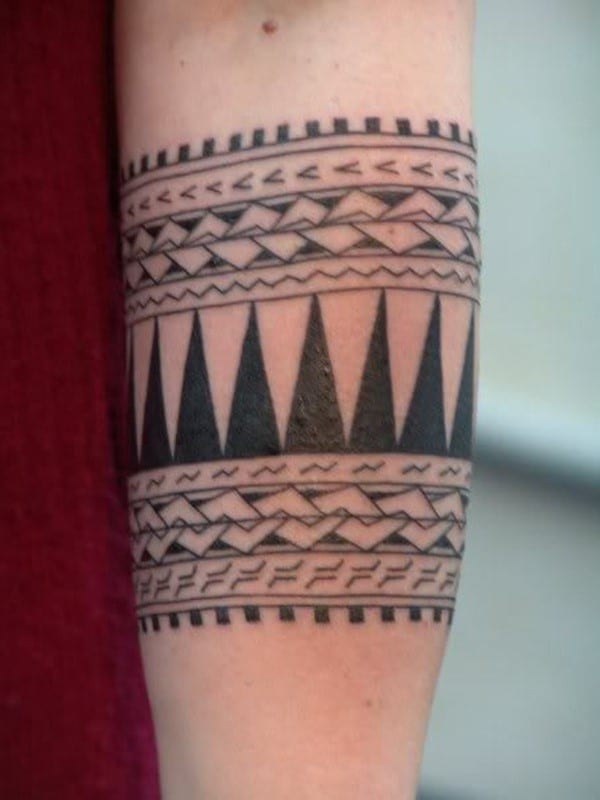
Huitzilopochtli was sometimes symbolized by a hummingbird – he wore hummingbird feathers in his helmet. More often, he was represented by an eagle sitting on a prickly pear cactus, holding a snake in one of its talons – interestingly, this is an image which today appears in the national flag of Mexico.
Recommended Reading: Don’t miss our ultimate guide to bear tattoos.
Tláloc
Tláloc was the other principal deity and was the god of rain, water, lightning, and agriculture. He could send rain to provide water for drinking and cultivating fields, but could also send storms and drought when angered.
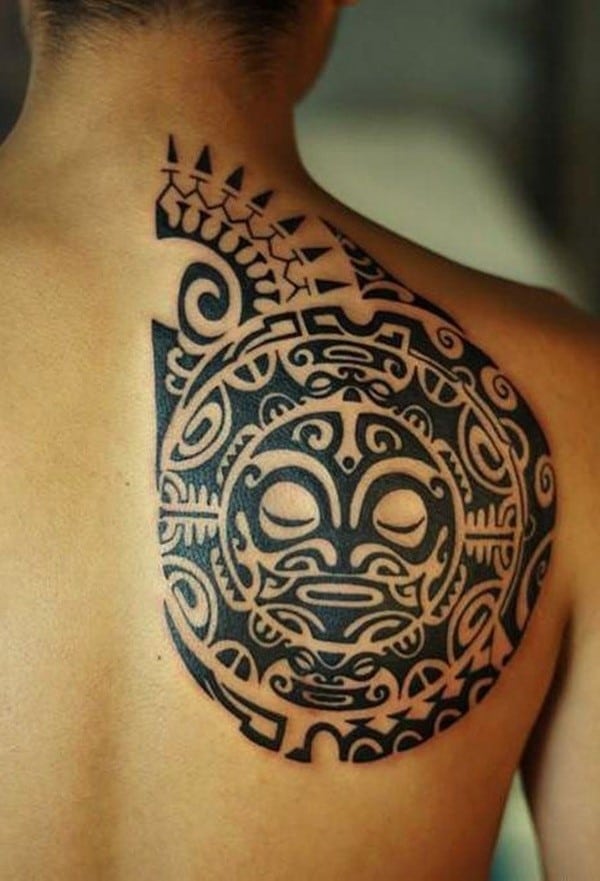
Often shown in the company of snakes, Tláloc was most commonly depicted as having goggled eyes and large fangs. His moth was sometimes shaped like a corn cob, to symbolize his power to provide rain for cultivation.
Other deities
Apart from these two most important gods, the Aztec pantheon also included:
- Quetzalcoatl – the creator of the world, the god of wind and rain, and the patron of learning, science, agriculture, crafts, and the arts. He was not exclusive to the Aztecs and appeared in the religions of other ancient Mesoamerican cultures. Depicted as a serpent with feathers.
- Tezcatlipoca – god of sustenance, warriors, and the embodiment of change through conflict. Depicted with a smoking mirror on his head and a serpent instead of a foot. Often, he’d wear a turquoise mask with a black eye band. Interestingly, he was usually represented in different colors depending on the direction he was meant to signify – black for north, blue for south, red for east, white for west.
- Xipe Totec – god of agriculture and Spring, often depicted with a large face, double lips, and sunken eyes. Sometimes shown as wearing the skin of one of the victims sacrificed to him.
- Xiuhtecuhtli – god of fire, often shown wearing a crown, with a blue bird hanging from his forehead and a fire serpent at his back.
- Xochipilli – god of flowers, love, dancing, creativity, and Summer. Portrayed in the company of butterflies, flowers, mushrooms, and animals; sometimes accompanied by a symbol of four dots which represented the sun.
- Mictlantecuhtli – god of the dead, associated with owls, spiders, bats, and the southern cardinal direction.
- Coatlicue – the earth-mother goddess and the patron of childbirth, often shown wearing a skirt of serpents, with large claws used to devour human corpses.
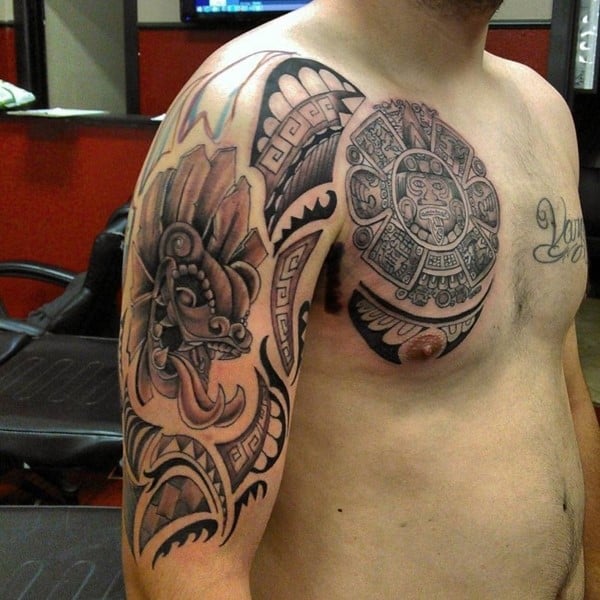
Aztec tattoo designs
Religious and mythological sculptures and paintings are the main source of Aztec art we have to drawn on for tattoo designs.
As a result, the deities described above feature heavily in modern Aztec tribal tattoos. Quetzalcoatl, the feathered snake, is most commonly used in contemporary Aztec tattoo art.
Eagle
An eagle is a revered symbol in Aztec culture. It’s the symbol of one of the most important gods, who – as we’ve already seen – sent an eagle to lead the Aztec people.
The eagle also represents a brave and high-ranking warrior. An eagle warrior would wear a traditional costume with special kind of headgear adorned with a large beak and feathers, making it bear resemblance to an eagle.
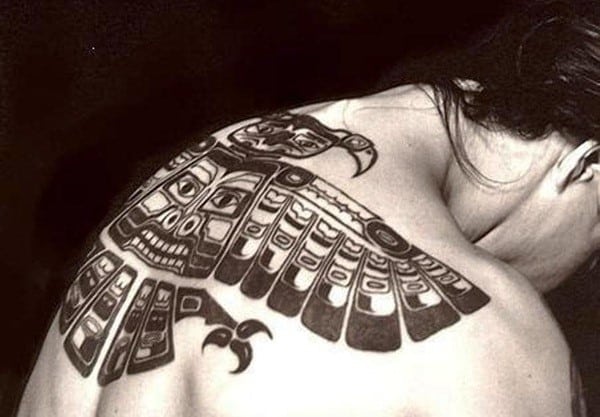
Associated with honor, nobility and courage, the eagle was revered also because could fly high, close to the sun, which was an object of worship for the Aztecs.
An Aztec eagle tattoo often features the bird with its beak open and its head pointing westwards. See some cool eagle tattoo ideas here.
Sun
The sun holds a revered – and complex – place in Aztec mythology, and in some ways was central to the culture and creation myths. As such, it’s a great subject for an Aztec tribal tattoo.
The Aztecs believed that the world had been created and destroyed four times in the past, and the current sun is the fifth one. Each sun-period was ruled by a different sun god.
The Aztec people offered plentiful sacrifices to the sun and its deity and observed a mourning ritual during solar eclipses.
Warrior
The Aztecs placed great importance upon warfare and their military – hey, they wouldn’t have conquered most of central Mexico had this not been true.
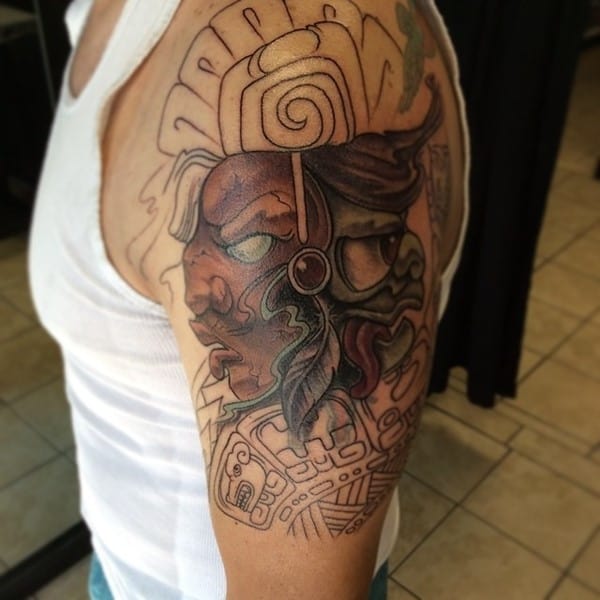
Warriors, therefore, held an important place in Aztec culture. A re-imagining of an Aztec warrior is one of the most popular choices for Aztec tattoo designs – usually accompanied by feathers or bird-themed headdresses.
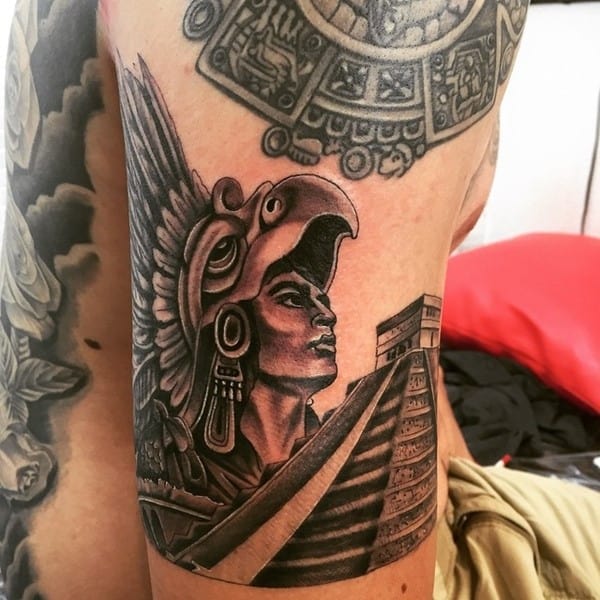
Calendar
The Aztec calendar design, often appropriated for tattoos, originates from a large stone carving found in Mexico City. The carving is circular in shape and highly intricate.
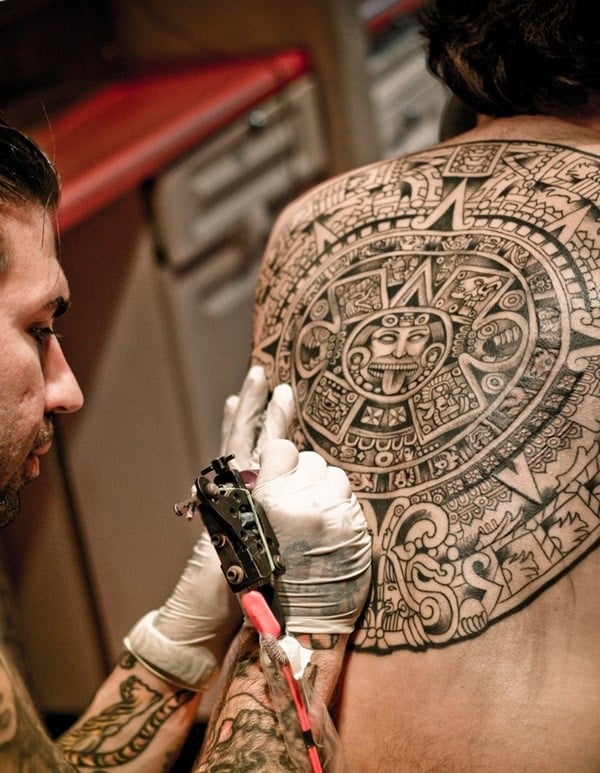
At the center of the design, there is the face of Tonatiuh – the fifth sun god. The surrounding pattern depicts the four past suns, jaguar heads representing the earth, and plenty of other complex symbolic imagery intended to convey the Aztec creation myth.
Aztec dates
Rather than getting a necessarily large tattoo of the full Aztec calendar stone, many people opt for an Aztec representation of a date significant to them, such as their birthday.
The Aztecs had a hugely complex calendar system, largely underpinned by the movements of the sun. The calendar differs from ours in the way that it counts days and years, not operating under the month system that we use nowadays.
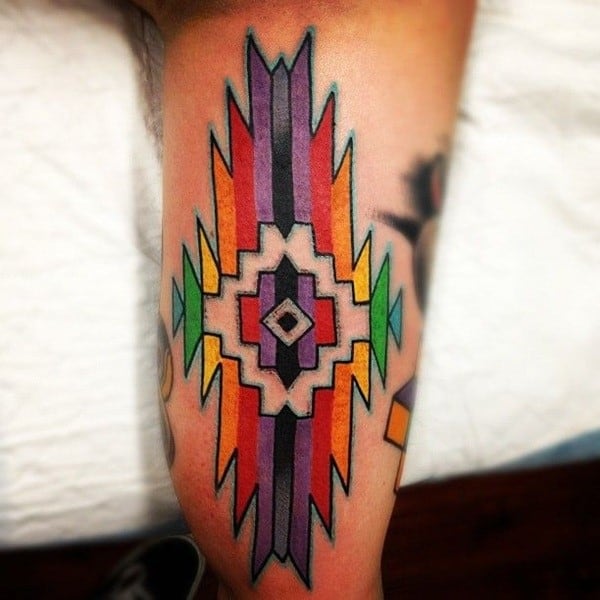
Helpfully, there are a number of websites out there that can help you convert a date into Aztec pictorial terms. Each date will involve three symbols – one for the day, one for the 13-day period (something like our week or month), and one for the solar year.
For instance, January 1, 2019 would be represented by symbols for the wind, the jaguar, and the reed.
This is a great choice if you’re looking for a tribal tattoo with deeply personal meaning, and/or you wish to get a tattoo of a date that’s not obvious to everyone who sees it.
Abstract patterns
Intricate geometric patterns drawing on ancient Aztec pottery decorations are another great choice of tattoo design.
One key advantage of these abstract drawings is that the resulting tattoo can cover an area of any size you like – they can range from very small to whole-body tattoos.
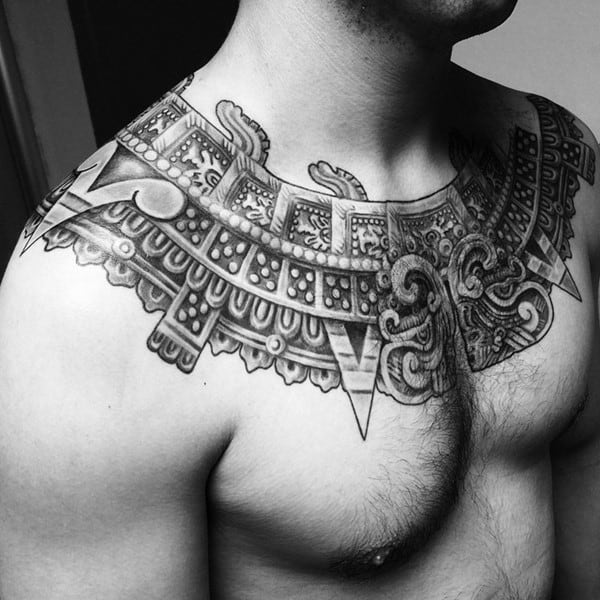
Since abstraction is the key element, you can also start with a smaller pattern and keep adding to it gradually at later dates.
Final words
Aztec tattoos carry deep mythological and cultural roots, and the patterns involved can be used by a skillful artist to create highly specific meanings that aren’t obvious to the casual observer.
Appropriating the Aztec imagery into modern tribal designs can yield striking and fully unique tattoos. We’ve gathered some of the best examples below – let us know which ones you like best!
